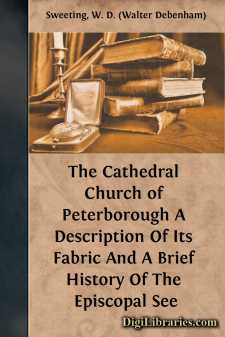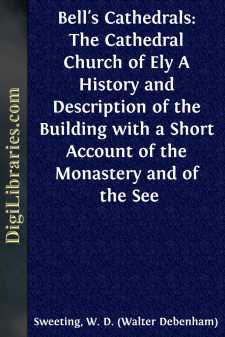Categories
- Antiques & Collectibles 13
- Architecture 36
- Art 48
- Bibles 22
- Biography & Autobiography 813
- Body, Mind & Spirit 142
- Business & Economics 28
- Children's Books 14
- Children's Fiction 11
- Computers 4
- Cooking 94
- Crafts & Hobbies 4
- Drama 346
- Education 46
- Family & Relationships 57
- Fiction 11829
- Games 19
- Gardening 17
- Health & Fitness 34
- History 1377
- House & Home 1
- Humor 147
- Juvenile Fiction 1873
- Juvenile Nonfiction 202
- Language Arts & Disciplines 88
- Law 16
- Literary Collections 686
- Literary Criticism 179
- Mathematics 13
- Medical 41
- Music 40
- Nature 179
- Non-Classifiable 1768
- Performing Arts 7
- Periodicals 1453
- Philosophy 64
- Photography 2
- Poetry 896
- Political Science 203
- Psychology 42
- Reference 154
- Religion 513
- Science 126
- Self-Help 84
- Social Science 81
- Sports & Recreation 34
- Study Aids 3
- Technology & Engineering 59
- Transportation 23
- Travel 463
- True Crime 29
The Cathedral Church of Peterborough A Description Of Its Fabric And A Brief History Of The Episcopal See
Categories:
Description:
Excerpt
CHAPTER I.
HISTORY OF THE CATHEDRAL CHURCH OF S. PETER.
Until the middle of the nineteenth century, Peterborough remained one of the most unchanged examples in the kingdom of the monastic borough. The place was called into existence by the monastery and was entirely dependent on it. The Abbot was supreme lord, and had his own gaol. He possessed great power over the whole hundred. And even after the See of Peterborough was constituted, and the Abbey Church became a cathedral, many of the ancient privileges were retained by the newly formed Dean and Chapter. They still retained the proclamation and control of the fairs; their officer, the high bailiff, was the returning officer at elections for parliament; they regulated the markets; they appointed the coroner. Professor Freeman contrasts an Abbot's town with a Bishop's town, when speaking about the city of Wells.[1] "An Abbot's borough might arise anywhere; no better instance can be found than the borough of S. Peter itself, that Golden Borough which often came to be called distinctively the Borough without further epithet." And again, "the settlement which arose around the great fenland monastery of S. Peter, the holy house of Medeshampstead, grew by degrees into a borough, and by later ecclesiastical arrangements, into a city, a city and borough to which the changes of our own day have given a growth such as it never knew before."
Situated on the edge of the Fens, some miles to the east of the great north road, without any special trade, and without any neighbouring territorial magnates, it is hardly surprising that the place seemed incapable of progress, and remained long eminently respectable and stagnant. In one of his caustic epigrams Dean Duport does indeed speak of the wool-combers as if there were a recognised calling that employed some numbers of men; but he is not complimentary to those employed, for he says that the men that comb the wool, and the sheep that bear it, are on a par as regards intelligence:
"At vos simplicitate pares et moribus estis,Lanificique homines, lanigerique greges."
In another epigram he derides the city itself, calling it contemptuously "Urbicula"; and he suggests, with a humour that to modern ideas savours of irreverence, that this little city of S. Peter's, "Petropolis," unless S. Peter had the keys, would run away through its own gates.
The great development of the last half of the nineteenth century is due to the railway works at New England, and to the Great Northern Line making Peterborough an important railway centre. In 1807 the entire population of the city and hamlets was under 3,500. In 1843 it was just over 5,500, and when the railway was laid it was not much more than 6,000. It has since gone up by leaps and bounds. In 1861 the population exceeded 11,000. By 1911 it had grown by steady increments to 33,578. The private diary of a resident of about 1850 would read like an old world record. The watchman in the Minster Precincts still went his rounds at night and called out the time and the weather; sedan-chairs were in use; the corn-market of the neighbourhood was held in the open street; turnpikes took toll at every road out of the town; a weekly paper had only just been started on a humble scale, being at first little more than a railway time-table with a few items of local news at the back; a couple of rooms more than sufficed for the business of the post office....



